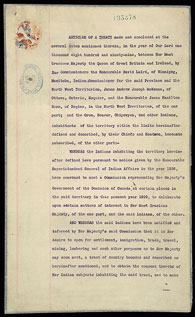Common menu bar links
Institutional links
ARCHIVED - Treaty 8
Archived Content
This archived Web page remains online for reference, research or recordkeeping purposes. This page will not be altered or updated. Web pages that are archived on the Internet are not subject to the Government of Canada Web Standards. As per the Communications Policy of the Government of Canada, you can request alternate formats of this page on the Contact Us page.
Introduction
First negotiated in late June 1899, Treaty 8 embraced an area in northwestern Canada of some 840,000 square kilometres -- more than three and a half times the size of Great Britain. At the time, it was not only the largest land settlement undertaken by the Canadian government with First Nations, but also the first to recognize that the "aboriginal title" of Indians and Métis are co-existent.
Although the original treaty is now a century old, its impact on the daily lives of First Nations and Métis peoples is no less significant than on the day it was first signed. Treaty 8 is very much a living document. It provides the basis for continuing relations between Natives of the Athabasca and the rest of Canada.
Credits:
Library and Archives of Canada wishes to acknowledge the assistance of the following in the preparation of this exhibition: Library and Archives of Canada, The Globe and Mail, the Saskatchewan Archives Board, Anne Cubitt, Brian Calliou, Dr. David Leonard and Dr. Frank Tough.

